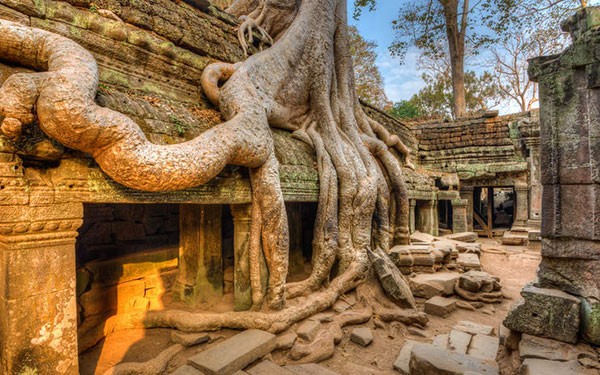Nestled in the dense jungles of Cambodia, Ta Prohm stands as a haunting testament to the passage of time. This legendary temple, part of the Angkor Wat complex, offers a unique glimpse into the harmonious yet powerful relationship between nature and architecture. Enormous trees rise from the ancient stones, their roots weaving through crumbling walls and forgotten corridors, creating a breathtaking, otherworldly landscape that captivates all who visit.
A Historical Marvel
Constructed in the late 12th century by the Khmer King Jayavarman VII, Ta Prohm was originally named Rajavihara, meaning “Monastery of the King.” The temple was dedicated to the king’s mother, symbolizing his devotion and reverence. As one of the most significant temples of the Khmer Empire, Ta Prohm was a sprawling complex, housing thousands of inhabitants, including priests, monks, and dancers.

Nature’s Embrace
What sets Ta Prohm apart from other temples in the Angkor Wat complex is its symbiotic relationship with nature. Unlike many other sites that have been extensively restored, Ta Prohm has been left largely in its natural state, with minimal intervention. This deliberate choice allows visitors to experience the temple much as it was discovered in the 19th century, enveloped by the jungle.
The most striking feature of Ta Prohm is the massive trees that have taken root among its ruins. The silk-cotton and strangler fig trees tower over the temple, their roots snaking through the stonework, creating an intricate tapestry of nature and man-made structures. This natural takeover gives Ta Prohm its distinctive and hauntingly beautiful appearance, as if the temple is being slowly reclaimed by the earth.
A UNESCO World Heritage Site

In 1992, Ta Prohm was designated a UNESCO World Heritage Site, along with the rest of the Angkor Archaeological Park. This recognition underscores the temple’s cultural and historical significance, as well as the need to preserve its unique character. Efforts to maintain Ta Prohm focus on stabilizing the ruins and managing the encroaching jungle without detracting from its raw and untouched beauty.
The Mystique of Ta Prohm
Walking through Ta Prohm is like stepping back in time. The temple’s corridors and courtyards, shrouded in shadows and greenery, evoke a sense of mystery and wonder. Each turn reveals a new scene: a tree root enveloping a doorway, a headless statue standing vigil, or a glimpse of the sky through a collapsed roof. The play of light and shadow creates an ever-changing landscape, inviting visitors to pause and contemplate the passage of time and the transient nature of human endeavors.

Ta Prohm also holds a certain mystique due to its appearance in popular culture. The temple gained worldwide fame after being featured in the 2001 film “Lara Croft: Tomb Raider.” The film’s depiction of Ta Prohm’s enchanting and eerie atmosphere has drawn countless visitors to its gates, eager to experience the real-life magic of this ancient site.
Preserving the Legacy
While Ta Prohm’s natural state is part of its charm, it also presents challenges for preservation. The delicate balance between nature and architecture requires ongoing efforts to ensure that the temple remains accessible and safe for future generations. Conservation projects, often led by international teams, work meticulously to maintain the integrity of the site while respecting its unique character.
Visiting Ta Prohm is not just an exploration of ancient ruins; it is an encounter with the relentless force of nature and the enduring legacy of human craftsmanship. The temple serves as a poignant reminder of the impermanence of our creations and the beauty that can arise when nature and history intertwine.

Conclusion
Ta Prohm is more than just a temple; it is a living monument to the passage of time. Its haunting beauty, where trees and stones coexist in a delicate dance, offers a profound reflection on the interplay between human civilization and the natural world. As visitors walk through its moss-covered corridors and gaze upon the colossal roots that embrace its walls, they are reminded of the enduring power of nature and the fleeting nature of human achievements. Ta Prohm stands as a timeless testament to the resilience of both, a place where history and nature come together in a breathtaking and unforgettable union.

